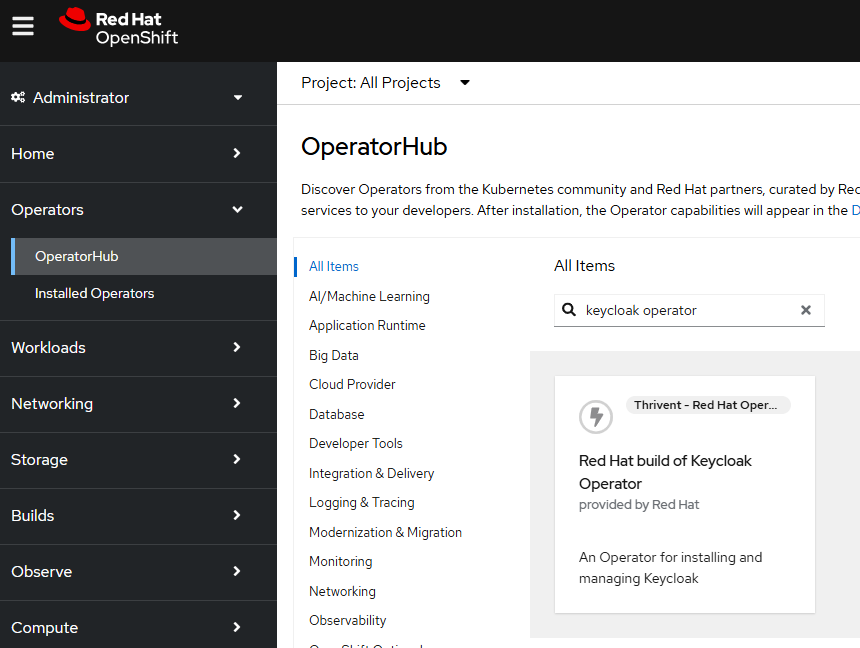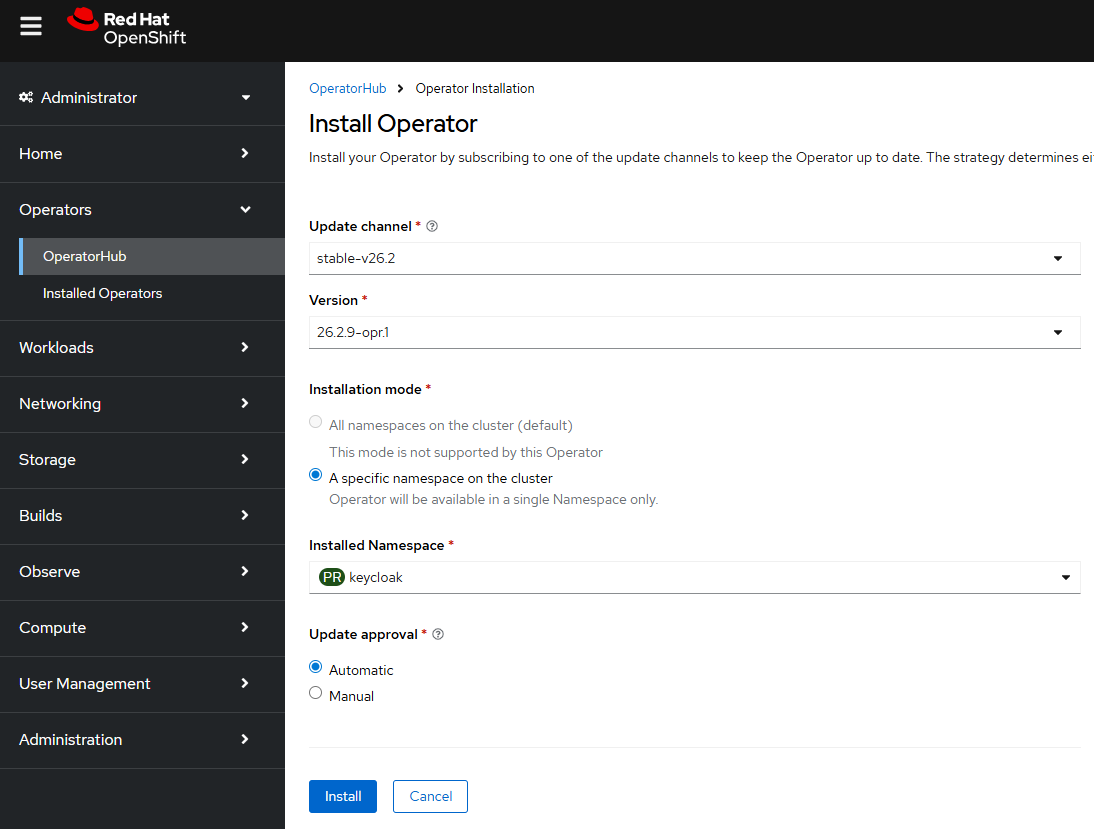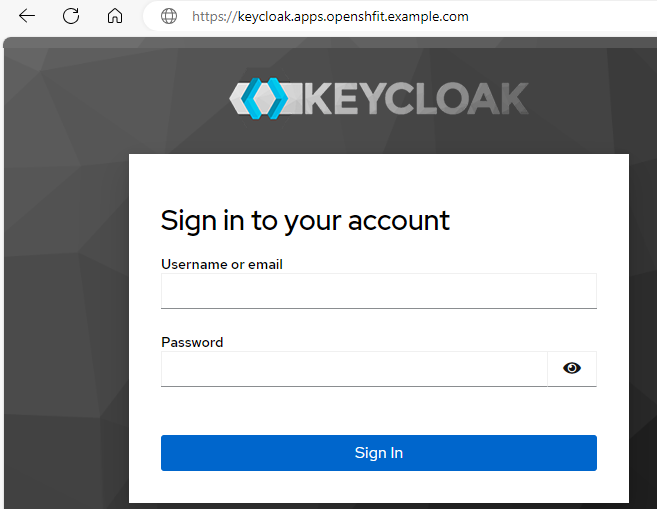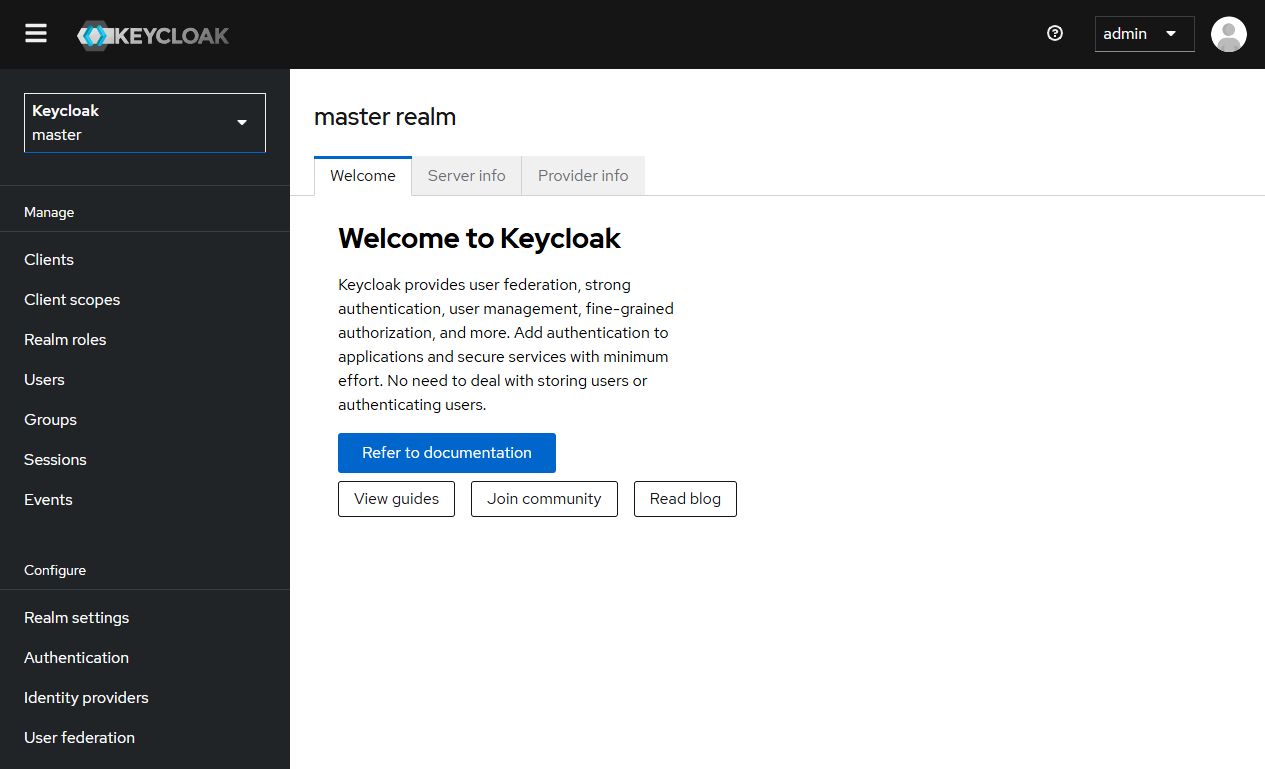
There are multiple ways to authenticate in OpenShift.
- htpasswd OAuth Identity Provider
- kubeadmin
- Keycloak
- Red Hat build of Keycloak Operator (this article)
- Getting Started with Keycloak
- SSO
Here are my notes as I prepared for the Red Hat Certified Specialist in OpenShift Automation and Integration exam (EX380).
In the OpenShift console, at Operators > Operator Hub search for the Red Hat build of Keycloak Operator.

And follow the prompts to install the operator.

The Operator should create a deployment which should spawn a replica set which should spawn a pod.
~]$ oc get all --namespace keycloak
NAME READY STATUS RESTARTS AGE
pod/rhbk-operator-57b47d9d66-56q58 1/1 Running 0 13s
NAME READY UP-TO-DATE AVAILABLE AGE
deployment.apps/rhbk-operator 1/1 1 1 23h
NAME DESIRED CURRENT READY AGE
replicaset.apps/rhbk-operator-57b47d9d66 1 1 1 13s
If the pod is in an Error state.
~]$ oc get pods --namespace keycloak
NAME READY STATUS RESTARTS AGE
pod/rhbk-operator-65ffd96644-f4wvx 0/1 Error 0 6s
And the pod logs has something like this.
~]$ oc logs pod/rhbk-operator-65ffd96644-f4wvx
--namespace keycloak
2025-10-02 01:13:02,481 ERROR [io.qua.run.Application] (main) Failed to start application: java.lang.RuntimeException: Failed to start quarkus
at io.quarkus.runner.ApplicationImpl.doStart(Unknown Source)
at io.quarkus.runtime.Application.start(Application.java:101)
at io.quarkus.runtime.ApplicationLifecycleManager.run(ApplicationLifecycleManager.java:121)
at io.quarkus.runtime.Quarkus.run(Quarkus.java:77)
at io.quarkus.runtime.Quarkus.run(Quarkus.java:48)
at io.quarkus.runtime.Quarkus.run(Quarkus.java:137)
at io.quarkus.runner.GeneratedMain.main(Unknown Source)
at io.quarkus.bootstrap.runner.QuarkusEntryPoint.doRun(QuarkusEntryPoint.java:68)
at io.quarkus.bootstrap.runner.QuarkusEntryPoint.main(QuarkusEntryPoint.java:36)
Caused by: java.lang.IllegalArgumentException: Failure in creating proxy URL. Proxy port is required!
This may occur if your OpenShift cluster has a proxy configured.
- FreeKB - OpenShift - HTTP_PROXY HTTPS_PROXY and NO_PROXY
- FreeKB - OpenShift - List proxy servers using the oc get proxy command
In this scenario, you may need to adjust the proxy configurations in the keycloak deployment. For example, I resolved the pod being in an Error state by removing the following from my keycloak deployment.
- name: HTTP_PROXY
value: http://proxy.example.com
- name: HTTPS_PROXY
value: https://proxy.example.com
- name: NO_PROXY
value: .cluster.local,.access.redhat.com,cloud.openshift.com,localhost,quay.io,registry.connect.redhat.com,registry.redhat.io
A stable pod should have logs that look something like this. Notice the pod is listening for connections on http://10.11.12.13:8080.
~]$ oc logs pod/rhbk-operator-57b47d9d66-56q58 --namespace keycloak
2025-10-02 01:14:26,319 WARN [io.qua.config] (main) Unrecognized configuration key "quarkus.operator-sdk.bundle.package-name" was provided; it will be ignored; verify that the dependency extension for this configuration is set or that you did not make a typo
2025-10-02 01:14:27,500 INFO [io.qua.ope.run.OperatorProducer] (main) Quarkus Java Operator SDK extension 7.1.1.redhat-00002 (commit: bbd08ea) built on Mon Apr 07 13:41:33 GMT 2025
2025-10-02 01:14:27,516 INFO [io.jav.ope.Operator] (main) Registered reconciler: 'keycloakrealmimportcontroller' for resource: 'class org.keycloak.operator.crds.v2alpha1.realmimport.KeycloakRealmImport' for namespace(s): [keycloak]
2025-10-02 01:14:27,600 INFO [io.jav.ope.Operator] (main) Registered reconciler: 'keycloakcontroller' for resource: 'class org.keycloak.operator.crds.v2alpha1.deployment.Keycloak' for namespace(s): [keycloak]
2025-10-02 01:14:27,600 INFO [io.qua.ope.run.AppEventListener] (main) Starting operator.
2025-10-02 01:14:27,600 INFO [io.jav.ope.Operator] (main) Operator SDK 5.0.4.redhat-00001 (commit: 2a58f2b) built on Thu Apr 03 15:50:23 GMT 2025 starting...
2025-10-02 01:14:27,600 INFO [io.jav.ope.Operator] (main) Client version: 7.1.0.redhat-00001
2025-10-02 01:14:27,601 INFO [io.jav.ope.pro.Controller] (Controller Starter for: keycloakrealmimportcontroller) Starting 'keycloakrealmimportcontroller' controller for reconciler: org.keycloak.operator.controllers.KeycloakRealmImportController, resource: org.keycloak.operator.crds.v2alpha1.realmimport.KeycloakRealmImport
2025-10-02 01:14:27,601 INFO [io.jav.ope.pro.Controller] (Controller Starter for: keycloakcontroller) Starting 'keycloakcontroller' controller for reconciler: org.keycloak.operator.controllers.KeycloakController, resource: org.keycloak.operator.crds.v2alpha1.deployment.Keycloak
2025-10-02 01:14:27,800 WARN [io.fab.kub.cli.dsl.int.VersionUsageUtils] (InformerWrapper [keycloakrealmimports.k8s.keycloak.org/v2alpha1] 27) The client is using resource type 'keycloakrealmimports' with unstable version 'v2alpha1'
2025-10-02 01:14:27,800 WARN [io.fab.kub.cli.dsl.int.VersionUsageUtils] (InformerWrapper [keycloaks.k8s.keycloak.org/v2alpha1] 26) The client is using resource type 'keycloaks' with unstable version 'v2alpha1'
2025-10-02 01:14:29,394 INFO [io.jav.ope.pro.Controller] (Controller Starter for: keycloakrealmimportcontroller) 'keycloakrealmimportcontroller' controller started
2025-10-02 01:14:29,697 INFO [io.jav.ope.pro.Controller] (Controller Starter for: keycloakcontroller) 'keycloakcontroller' controller started
2025-10-02 01:14:29,716 INFO [io.quarkus] (main) keycloak-operator 26.2.9.redhat-00001 on JVM (powered by Quarkus 3.20.2.redhat-00004) started in 4.293s. Listening on: http://10.11.12.13:8080
2025-10-02 01:14:29,716 INFO [io.quarkus] (main) Profile prod activated.
2025-10-02 01:14:29,716 INFO [io.quarkus] (main) Installed features: [cdi, kubernetes, kubernetes-client, openshift-client, operator-sdk, smallrye-context-propagation, smallrye-health, vertx]
Also, the deployment should have label name: rhbk-operator.
~]$ oc get pod/rhbk-operator-57b47d9d66-56q58 --namespace keycloak --output jsonpath="{.metadata.labels}"
{"name":"rhbk-operator","pod-template-hash":"57b47d9d66"}
Postgres Config Map
Keycloak requires a Postgres database that contains a database named keycloak that keycloak will use to store data.
Check out my article FreeKB - Postgres (SQL) - Deploy Postgres on OpenShift for a general walkthrough on how to deploy Postgres on OpenShift.
Since the name of the Postgres database and the username are not sensitive data, these values can be stored in a Config Map. Check out my article FreeKB - OpenShift - Create Config Map. Let's say you have the following in a YAML file. It's important here that the POSTGRESQL_DATABASE is keycloak as keycloak expects the database name to be keycloak.
apiVersion: v1
kind: ConfigMap
metadata:
name: postgres
labels:
app: postgres
data:
POSTGRESQL_DATABASE: keycloak
POSTGRESQL_USER: admin
The oc apply command with the -f or --filename option can be used to create the config map using the template YAML file.
~]$ oc apply --filename configmap.yml
configmap/postgres created
The oc get configmaps command can be used to list the config maps that have been created.
~]$ oc get configmaps
NAME DATA AGE
postgres 2 11m
And you can validate that the config maps contains the postgres database name and username.
~]$ oc get configmap postgres --output jsonpath="{.data}"
{"POSTGRESQL_DATABASE":"keycloak","POSTGRESQL_USER":"admin"}
Postgres Secret
Since the Postgres password is sensitive data, this should be created in a secret. Check out my article FreeKB - OpenShift - Create Opaque Generic Secrets (key value pairs). Let's say you want your admin password to be itsasecret. The base64 command can be used to get the base64 of itsasecret.
~]$ echo itsasecret | base64
aXRzYXNlY3JldAo=
Let's say you have the following in a YAML file. Notice the value is aXRzYXNlY3JldAo=, which is the base64 of itsasecret.
apiVersion: v1
kind: Secret
metadata:
name: postgres
labels:
app: postgres
data:
POSTGRESQL_PASSWORD: aXRzYXNlY3JldAo=
POSTGRESQL_ADMIN_PASSWORD: aXRzYXNlY3JldAo=
The oc apply command with the -f or --filename option can be used to create the secret using the template YAML file.
~]$ oc create --filename secret.yml
secret/postgres created
The oc get secrets command can be used to list the secrets that have been created.
~]# oc get secrets
NAME TYPE DATA AGE
postgres Opaque 1 30s
And you can validate that the secret contains the password.
]$ oc get secret postgres --output jsonpath="{.data}"
{"POSTGRESQL_ADMIN_PASSWORD":"aXRzYXNlY3JldAo=","POSTGRESQL_PASSWORD":"aXRzYXNlY3JldAo="}
~]$ oc get secret postgres --output jsonpath="{.data.POSTGRESQL_PASSWORD}" | base64 --decode
itsasecret
~]$ oc get secret postgres --output jsonpath="{.data.POSTGRESQL_ADMIN_PASSWORD}" | base64 --decode
itsasecret
Postgres Persistent Volume
In this example, the Postgres will be configured to store it's data in a Persistent Volume. The oc get storageclass command can be used to list the available storage classes in your OpenShift cluster.
]$ oc get storageclasses
NAME PROVISIONER RECLAIMPOLICY VOLUMEBINDINGMODE ALLOWVOLUMEEXPANSION AGE
file-storage (default) csi.trident.netapp.io Delete Immediate true 2y113d
thin kubernetes.io/vsphere-volume Delete Immediate false 2y116d
thin-csi csi.vsphere.vmware.com Delete WaitForFirstConsumer true 2y116d
Let's say you have the following in a YAML file. Notice in this example that the Persistent Volume will use one of the available storage classes (file-storage in this example). It is also important that the Persistent Volume Claim gets created in the keycloak namespace.
apiVersion: v1
kind: PersistentVolumeClaim
metadata:
name: postgres
namespace: keycloak
labels:
app: postgres
spec:
accessModes:
- ReadWriteMany
resources:
requests:
storage: 5Gi
storageClassName: file-storage
The oc apply command with the -f or --filename option can be used to create the persistent volume claim using the template YAML file.
~]$ oc create --filename pvc.yml
persistentvolumeclaim/postgres created
The oc get persistentvolumeclaims (or oc get pvc) command will return the list of persistent volume claims.
~]$ oc get pvc --namespace keycloak
NAME STATUS VOLUME CAPACITY ACCESS MODES STORAGECLASS VOLUMEATTRIBUTESCLASS AGE
postgres Bound pvc-80bc89a3-f4d4-4786-9649-9de9536d2e2b 5Gi RWX file-storage <unset> 3m29s
And the oc get persistentvolumes (or oc get pv) command should list the persistent volume.
~]$ oc get pv
NAME CAPACITY ACCESS MODES RECLAIM POLICY STATUS CLAIM STORAGECLASS REASON AGE
pvc-80bc89a3-f4d4-4786-9649-9de9536d2e2b 5Gi RWX Delete Bound keycloak/postgres file-storage 19m
Postgres Service
By default, postgres listens for connections on port 5432. Check out my article FreeKB - OpenShift - Create ClusterIP Service. Let's say you have the following in a YAML file.
apiVersion: v1
kind: Service
metadata:
name: postgres
namespace: keycloak
labels:
app: postgres
spec:
selector:
app: postgres
ports:
- protocol: TCP
port: 5432
targetPort: 5432
type: ClusterIP
The oc apply command with the -f or --filename option can be used to create the service using the template YAML file.
~]$ oc create --filename service.yml
service/postgres created
The oc get services command can be used to list the services that have been created.
]$ oc get services
NAME TYPE CLUSTER-IP EXTERNAL-IP PORT(S) AGE
postgres ClusterIP 172.30.53.213 <none> 5432/TCP 24m
Postgres Stateful Set
Now that we have the config map, secret, service, and persistent volume / persistent volume claim, we can create the stateful set.
The oc get images command can be used to list the postgres images that have been imported into your OpenShift cluster.
]$ oc get images | grep -i postgres
sha256:0b939c13john.doe43a85b813ec8c170adcb7479507ed4e592d982296f745c62e registry.redhat.io/rhel8/postgresql-15@sha256:0b939c13john.doe43a85b813ec8c170adcb7479507ed4e592d982296f745c62e
sha256:12b1d5a86864d21d6594384edfe5cccc94205dbf689fjohn.doe78901237060a5 registry.redhat.io/rhel8/postgresql-13@sha256:12b1d5a86864d21d6594384edfe5cccc94205dbf689fjohn.doe78901237060a5
sha256:1d1d42ba374084d59308f44aafdab883145b06ca109aa7c2f362a578a6abf318 registry.redhat.io/rhel9/postgresql-13@sha256:1d1d42ba374084d59308f44aafdab883145b06ca109aa7c2f362a578a6abf318
sha256:72a123456789012359429b9bbb172c4363efe32d9a1490d25f5e313041022c7a registry.redhat.io/rhel8/postgresql-13@sha256:72a123456789012359429b9bbb172c4363efe32d9a1490d25f5e313041022c7a
sha256:a1c75f08c929a4992816b8b91f9372852aefe46e183d3cf0464dd5dbe3d836a1 registry.redhat.io/rhel8/postgresql-10@sha256:a1c75f08c929a4992816b8b91f9372852aefe46e183d3cf0464dd5dbe3d836a1
sha256:a21e2a6d92d4ejohn.doe19d6a382f379a12d3ee7a8abe3e74fc01ba0cf56a232 registry.redhat.io/rhscl/postgresql-10-rhel7@sha256:a21e2a6d92d4ejohn.doe19d6a382f379a12d3ee7a8abe3e74fc01ba0cf56a232
sha256:bbe3dd60fefb35dbaf2ee8f45d0b0b903fc5ceab9f58fb522ebd3d9aee4f535f registry.redhat.io/rhel8/postgresql-12@sha256:bbe3dd60fefb35dbaf2ee8f45d0b0b903fc5ceab9f58fb522ebd3d9aee4f535f
sha256:c6fde1a8653a597c18b0326bc71ce4a614273be74b9aef3ced83a1b11472687a registry.redhat.io/rhscl/postgresql-13-rhel7@sha256:c6fde1a8653a597c18b0326bc71ce4a614273be74b9aef3ced83a1b11472687a
sha256:d05fd5870e03045baeb1113c913b290e56616a307a559c067c6a57cfcb60e1a2 registry.redhat.io/rhel9/postgresql-15@sha256:d05fd5870e03045baeb1113c913b290e56616a307a559c067c6a57cfcb60e1a2
sha256:d99bb8c63bbdbbfb1bd1a1f4e1a5f114dc5a0d972cdd9d27ca9e69c16cb98089 registry.redhat.io/rhscl/postgresql-12-rhel7@sha256:d99bb8c63bbdbbfb1bd1a1f4e1a5f114dc5a0d972cdd9d27ca9e69c16cb98089
Let's say you have the following in a YAML file. You may need to update image to reference one of the postgres images in your cluster
apiVersion: apps/v1
kind: StatefulSet
metadata:
name: postgres
labels:
app: postgres
spec:
replicas: 1
serviceName: postgres
selector:
matchLabels:
app: postgres
template:
metadata:
labels:
app: postgres
spec:
containers:
- env:
- name: POSTGRESQL_USER
valueFrom:
configMapKeyRef:
name: postgres
key: POSTGRESQL_USER
- name: POSTGRESQL_PASSWORD
valueFrom:
secretKeyRef:
name: postgres
key: POSTGRESQL_PASSWORD
- name: POSTGRES_DB
valueFrom:
configMapKeyRef:
name: postgres
key: POSTGRES_DB
- name: PGDATA
value: /data/pgdata
image: registry.redhat.io/rhel9/postgresql-15
ports:
- containerPort: 5432
name: postgres
volumeMounts:
- mountPath: /data
name: postgres-vm
volumes:
- name: postgres-vm
persistentVolumeClaim:
claimName: postgres
The oc apply command with the -f or --filename option can be used to create the stateful set using the template YAML file.
~]$ oc apply -f statefulset.yml
statefulset/postgres created
The oc get statefulsets command will return the list of stateful sets. Since the stateful set YAML had replicas: 1 this is why 1 pod was created by the stateful set. In this example, since ready is 1/1 this means there should be a running postgres pod.
]$ oc get statefulsets
NAME READY AGE
postgres 1/1 27m
And the oc get pods command can be used to ensure the postgres pod is running.
$ oc get pods
NAME READY STATUS RESTARTS AGE
postgres-0 1/1 Running 0 29m
And the pod logs should return something like this.
]$ oc logs pod/postgres-0
The files belonging to this database system will be owned by user "postgres".
This user must also own the server process.
The database cluster will be initialized with locale "en_US.utf8".
The default database encoding has accordingly been set to "UTF8".
The default text search configuration will be set to "english".
Data page checksums are disabled.
fixing permissions on existing directory /var/lib/pgsql/data/userdata ... ok
creating subdirectories ... ok
selecting dynamic shared memory implementation ... posix
selecting default max_connections ... 100
selecting default shared_buffers ... 128MB
selecting default time zone ... UTC
creating configuration files ... ok
running bootstrap script ... ok
performing post-bootstrap initialization ... ok
syncing data to disk ... ok
initdb: warning: enabling "trust" authentication for local connections
initdb: hint: You can change this by editing pg_hba.conf or using the option -A, or --auth-local and --auth-host, the next time you run initdb.
Success. You can now start the database server using:
pg_ctl -D /var/lib/pgsql/data/userdata -l logfile start
waiting for server to start....2025-10-09 01:15:43.003 UTC [35] LOG: redirecting log output to logging collector process
2025-10-09 01:15:43.003 UTC [35] HINT: Future log output will appear in directory "log".
done
server started
/var/run/postgresql:5432 - accepting connections
=> sourcing /usr/share/container-scripts/postgresql/start/set_passwords.sh ...
ALTER ROLE
waiting for server to shut down.... done
server stopped
Starting server...
2025-10-09 01:15:43.244 UTC [1] LOG: redirecting log output to logging collector process
2025-10-09 01:15:43.244 UTC [1] HINT: Future log output will appear in directory "log".
And using the psql CLI in the pod, you should see there is a database named keycloak that is owned by admin.
]$ oc exec pod/postgres-0 -- psql --list
List of databases
Name | Owner | Encoding | Collate | Ctype | ICU Locale | Locale Provider | Access privileges
-----------+----------+----------+------------+------------+------------+-----------------+-----------------------
keycloak | admin | UTF8 | en_US.utf8 | en_US.utf8 | | libc |
postgres | postgres | UTF8 | en_US.utf8 | en_US.utf8 | | libc |
template0 | postgres | UTF8 | en_US.utf8 | en_US.utf8 | | libc | =c/postgres +
| | | | | | | postgres=CTc/postgres
template1 | postgres | UTF8 | en_US.utf8 | en_US.utf8 | | libc | =c/postgres +
| | | | | | | postgres=CTc/postgres
(4 rows)
SSL Certificate
Next let's create an SSL certificate for keycloak. This example uses cert-manager. Check out my article FreeKB - OpenShift - Create SSL certificate using cert-manager.
Before creating a new SSL certificate using cert-manager, you are going to want to list the available issuers. The oc get issuers command can be used to list the issues that can be used by cert-manager. It's fairly common for the oc get issuers command to return "No resources found" since issues are typically a cluster wide resource and not limited to a particular namespace.
~]$ oc get issuers --all-namespaces
No resources found
The oc get clusterissuers command can be used to list the issuers that cert-manager can used in any namespace in the OpenShift cluster.
~]$ oc get clusterissuers
NAME READY AGE
public-clusterissuer True 649d
internal-clusterissuer True 471d
Let's say you have the following in a YAML file. Notice the YAML includes one of the issuers, internal-clusterissuer in this example. Notice also that the common name and dnsNames for the certificate is keycloak.apps.openshift.example.com in this example.
apiVersion: cert-manager.io/v1
kind: Certificate
metadata:
name: my-certificate
namespace: keycloak
spec:
commonName: keycloak.apps.openshift.example.com
dnsNames:
- "keycloak.apps.openshift.example.com"
duration: 8760h0m0s
isCA: false
issuerRef:
kind: ClusterIssuer
name: internal-clusterissuer
privateKey:
algorithm: RSA
encoding: PKCS1
rotationPolicy: Always
size: 2048
renewBefore: 360h0m0s
secretName: my-secret
subject:
countries:
- US
localities:
- Los Angeles
organizationalUnits:
- Information Technology
organizations:
- Acme
provinces:
- CA
usages:
- server auth
The oc apply command can be used to create the Certificate resource.
oc apply --filename my-certificate.yml
Then the oc get certificates command can be used to list the cert-manager certificates in the namespace the certificate was created in. You want to ensure the certificate READY is True.
]$ oc get certificates --namespace my-project
NAME READY SECRET AGE
my-certificate True my-secret 2m37s
KeyCloak Resource
Last but not least, let's create the keycloak resource.
- spec.db.usernameSecret.name must be the name of secret you created
- spec.db.usernameSecret.key must be the name of the key in the secret that contains your postgres username
- spec.db.passwordSecret.name must be the name of secret you created
- spec.db.passwordSecret.key must be the name of the key in the secret that contains your postgres password
- spec.http.tlsSecret must be the name of the secret for your SSL certificate
- spec.hostname must be the common name and dnsNames for your SSL certificate
apiVersion: k8s.keycloak.org/v2alpha1
kind: Keycloak
metadata:
name: keycoak
labels:
app: keycloak
spec:
db:
vendor: postgres
host: postgres
usernameSecret:
name: postgres
key: username
passwordSecret:
name: postgres
key: password
http:
tlsSecret: keycloak-certificate
hostname:
hostname: keycloak.apps.openshift.example.com
instances: 1
networkPolicy:
enabled: false # this is optional - if excluded, this will default to true and create a Network Policy
proxy:
headers: xforwarded
The oc apply command can be used to create the keycloak resource.
oc apply --filename keycloak.yml
And then the oc get keycloak command can be used to see that the keycloak resource has been created.
]$ oc get keycloak --namespace keycloak
NAME AGE
keycloak 35m
The keycloak resource should create a stateful set.
]$ oc get statefulsets --namespace keycloak
NAME READY AGE
keycloak 1/1 36m
And the stateful set should spawn a pod.
]$ oc get pods --namespace keycloak
NAME READY STATUS RESTARTS AGE
keycloak-0 1/1 Running 0 36m
postgres-0 1/1 Running 0 39m
rhbk-operator-78d6459ddd-s77rl 1/1 Running 0 24h
The keycloak pod logs should return something like this.
]$ oc logs pod/keycloak-0 --namespace keycloak
Changes detected in configuration. Updating the server image.
Updating the configuration and installing your custom providers, if any. Please wait.
2025-10-31 01:06:20,477 INFO [io.quarkus.deployment.QuarkusAugmentor] (main) Quarkus augmentation completed in 3269ms
Server configuration updated and persisted. Run the following command to review the configuration:
kc.sh show-config
Next time you run the server, just run:
kc.sh --verbose start --optimized
WARNING: The following used run time options are UNAVAILABLE and will be ignored during build time:
- tracing-service-name: Available only when Tracing is enabled.
- tracing-resource-attributes: Available only when Tracing is enabled.
2025-10-31 01:06:23,482 INFO [org.keycloak.quarkus.runtime.storage.database.liquibase.QuarkusJpaUpdaterProvider] (main) Initializing database schema. Using changelog META-INF/jpa-changelog-master.xml
2025-10-31 01:06:27,795 INFO [org.keycloak.quarkus.runtime.storage.infinispan.CacheManagerFactory] (main) Starting Infinispan embedded cache manager
2025-10-31 01:06:28,090 INFO [org.keycloak.quarkus.runtime.storage.infinispan.CacheManagerFactory] (main) JGroups Encryption enabled (mTLS).
2025-10-31 01:06:28,150 INFO [org.infinispan.CONTAINER] (main) Virtual threads support enabled
2025-10-31 01:06:28,192 INFO [org.keycloak.infinispan.module.certificates.CertificateReloadManager] (main) Starting JGroups certificate reload manager
2025-10-31 01:06:28,299 INFO [org.infinispan.CONTAINER] (main) ISPN000556: Starting user marshaller 'org.infinispan.commons.marshall.ImmutableProtoStreamMarshaller'
2025-10-31 01:06:28,424 INFO [org.infinispan.CLUSTER] (main) ISPN000078: Starting JGroups channel `ISPN` with stack `kubernetes`
2025-10-31 01:06:28,425 INFO [org.jgroups.JChannel] (main) local_addr: b9cc5b49-663f-4661-9615-1fbdcc41f95e, name: example-kc-0-53579
2025-10-31 01:06:28,432 INFO [org.jgroups.protocols.FD_SOCK2] (main) server listening on *:57800
2025-10-31 01:06:30,434 INFO [org.jgroups.protocols.pbcast.GMS] (main) example-kc-0-53579: no members discovered after 2001 ms: creating cluster as coordinator
2025-10-31 01:06:30,446 INFO [org.infinispan.CLUSTER] (main) ISPN000094: Received new cluster view for channel ISPN: [example-kc-0-53579|0] (1) [example-kc-0-53579]
2025-10-31 01:06:30,447 INFO [org.keycloak.infinispan.module.certificates.CertificateReloadManager] (main) Reloading JGroups Certificate
2025-10-31 01:06:30,469 INFO [org.infinispan.CLUSTER] (main) ISPN000079: Channel `ISPN` local address is `example-kc-0-53579`, physical addresses are `[10.131.19.254:7800]`
2025-10-31 01:06:30,711 INFO [org.keycloak.connections.infinispan.DefaultInfinispanConnectionProviderFactory] (main) Node name: example-kc-0-53579, Site name: null
2025-10-31 01:06:30,795 INFO [org.keycloak.services] (main) KC-SERVICES0050: Initializing master realm
2025-10-31 01:06:31,564 INFO [org.keycloak.services] (main) KC-SERVICES0077: Created temporary admin user with username temp-admin
2025-10-31 01:06:31,680 INFO [io.quarkus] (main) Keycloak 26.2.10.redhat-00002 on JVM (powered by Quarkus 3.20.3.redhat-00003) started in 11.116s. Listening on: https://0.0.0.0:8443. Management interface listening on https://0.0.0.0:9000.
2025-10-31 01:06:31,680 INFO [io.quarkus] (main) Profile prod activated.
2025-10-31 01:06:31,680 INFO [io.quarkus] (main) Installed features: [agroal, cdi, hibernate-orm, jdbc-postgresql, keycloak, narayana-jta, opentelemetry, reactive-routes, rest, rest-jackson, smallrye-context-propagation, smallrye-health, vertx]
The kcadm CLI should return stdout.
~]$ oc exec pod/keycloak-0 --namespace keycloak -- /opt/keycloak/bin/kcadm.sh --help
Keycloak Admin CLI
Use 'kcadm.sh config credentials' command with username and password to start a session against a specific
server and realm.
For example:
$ kcadm.sh config credentials --server http://localhost:8080 --realm master --user admin
Enter password:
Logging into http://localhost:8080 as user admin of realm master
Any configured username can be used for login, but to perform admin operations the user
needs proper roles, otherwise operations will fail.
Usage: kcadm.sh COMMAND [ARGUMENTS]
Global options:
-x Print full stack trace when exiting with error
--help Print help for specific command
--config Path to the config file (~/.keycloak/kcadm.config by default)
Commands:
config Set up credentials, and other configuration settings using the config file
create Create new resource
get Get a resource
update Update a resource
delete Delete a resource
get-roles List roles for a user or a group
add-roles Add role to a user or a group
remove-roles Remove role from a user or a group
set-password Re-set password for a user
help This help
Use 'kcadm.sh help <command>' for more information about a given command.
The keycloak resource will also create two services, keycloak-discovery and keycloak-service.
~]$ oc get services --namespace keycloak
NAME TYPE CLUSTER-IP EXTERNAL-IP PORT(S) AGE
keycloak-discovery ClusterIP None <none> 7800/TCP 5d
keycloak-service ClusterIP 172.30.99.133 <none> 8443/TCP,9000/TCP 5d
postgres ClusterIP 172.30.53.213 <none> 5432/TCP 27d
The keycloak resource will also create an ingress route that will route requests onto the keycloak-service, and the keycloak-service will route requests onto the keycloak pod.
~]$ oc get ingress --namespace keycloak
NAME CLASS HOSTS ADDRESS PORTS AGE
keycloak-ingress <none> keycloak.apps.openshift.example.com 80 5d
~]$ oc get routes
NAME HOST/PORT PATH SERVICES PORT TERMINATION WILDCARD
keycloak-ingress-x5bjm keycloak.apps.openshift.example.com keycloak-service https passthrough/Redirect None
If you have more than one type of ingress routers, such as "default" and "internal" and "external" in this example . . .
~]$ oc get pods --namespace openshift-ingress
NAME READY STATUS RESTARTS AGE
router-default-6f84fdff65-4zdmp 1/1 Running 0 557d
router-default-6f84fdff65-t7h22 1/1 Running 0 557d
router-default-6f84fdff65-z579b 1/1 Running 0 557d
router-internal-247fda1127-jmhv5 1/1 Running 0 342d
router-internal-247fda1127-sqqhc 1/1 Running 0 342d
router-internal-247fda1127-knlt2 1/1 Running 0 342d
router-external-f58b6de991-qng54 1/1 Running 0 340d
router-external-6f84fdff65-vcrn2 1/1 Running 0 340d
router-external-6f84fdff65-px6s8 1/1 Running 0 340d
You may need to label the route to get the route exposed on one of the ingress routers, such as the "default" or "internal" or "external" routers.
oc label route my-route route-type=default
The keycloak resource will also create a network policy that allows ingress requests.
~]$ oc get networkpolicy keycloak-network-policy --namespace keycloak --output yaml
apiVersion: networking.k8s.io/v1
kind: NetworkPolicy
metadata:
annotations:
javaoperatorsdk.io/previous: 7f3b785a-6a86-4dbf-8a02-11b86f15af48
creationTimestamp: "2025-10-31T01:45:29Z"
generation: 1
labels:
app: keycloak
app.kubernetes.io/instance: keycloak
app.kubernetes.io/managed-by: keycloak-operator
name: keycloak-network-policy
namespace: keycloak
ownerReferences:
- apiVersion: k8s.keycloak.org/v2alpha1
kind: Keycloak
name: keycloak
uid: e46c1c2a-77bb-4f18-9770-c34777cb8a75
resourceVersion: "655702846"
uid: 283d2fb7-fbd6-4bd1-b624-c7482a08b3a3
spec:
ingress:
- ports:
- port: 8443
protocol: TCP
- from:
- podSelector:
matchLabels:
app: keycloak
app.kubernetes.io/instance: keycloak
app.kubernetes.io/managed-by: keycloak-operator
ports:
- port: 7800
protocol: TCP
- port: 57800
protocol: TCP
- ports:
- port: 9000
protocol: TCP
podSelector:
matchLabels:
app: keycloak
app.kubernetes.io/instance: keycloak
app.kubernetes.io/managed-by: keycloak-operator
policyTypes:
- Ingress
Does it actually work?
Now you can go to the URL of your route and if all goes according to plan, you should be presented with the admin console sign in page. Awesome!

You should be able to sign into the console using the KC_BOOTSTRAP_ADMIN_USERNAME and KC_BOOTSTRAP_ADMIN_PASSWORD, which is admin and itsasecret in this example.
~]$ oc exec pod/keycloak-0 --namespace keycloak -- printenv
KC_BOOTSTRAP_ADMIN_USERNAME=admin
KC_BOOTSTRAP_ADMIN_PASSWORD=itsasecret
Once signed into the console, you should see something like this.

Did you find this article helpful?
If so, consider buying me a coffee over at 